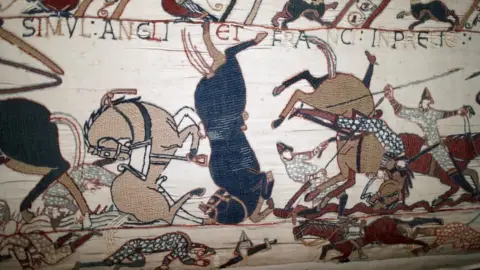The Bayeux Tapestry, which documents the Norman invasion of England in 1066, will be closed to the public in France from Monday as opposition mounts ahead of its move to London. The next time it will be possible to see the nearly 1,000-year-old work of art should be when it goes on display at the British Museum in September next year. However, the French art world is fiercely opposed to the project, with experts fearing the 70m-long (230ft) masterpiece is in far too delicate a state to be transported across the Channel.
French President Emmanuel Macron and Prime Minister Sir Keir Starmer announced the loan when they met in London in July. The last few weeks have seen a big rise in visitor numbers at the Bayeux Museum ahead of its closure from 1 September. A new display area is being built for the tapestry, which will take at least two years.
The closure – long planned – is what gave Macron the opportunity to perform his act of cultural diplomacy, committing France to loaning the tapestry to the British Museum for a year from next September. But that promise has triggered an outcry from many in the French art world, as a petition has drawn 60,000 signatures, describing the loan as a cultural crime.
Many critics resent the way Macron decided to make this gesture to the UK, feeling that the advice of specialists—who warn that vibrations from a long journey by road could cause irreparable damage—was wholly overridden.
On 22 August, a French official overseeing the loan defended the decision, stating that the tapestry was not too fragile to transport. Philippe Bélaval, the official, cited a study outlining recommendations for handling and transport, which reportedly does not label the tapestry as untransportable. However, Cecile Binet, a regional museum adviser for Normandy, has argued that moving the tapestry long distances poses a substantial risk to its conservation.
This famous embroidery, created in Kent, will be displayed in London from next autumn until July 2027. In exchange, artefacts from the Anglo-Saxon burial mounds at Sutton Hoo and the 12th Century Lewis chess pieces will take their place in Normandy museums. The Bayeux Tapestry charts a contested period in Anglo-French relations, illustrating the transition from Anglo Saxon dominance to Norman rule and features 58 scenes, 626 characters, and 202 horses, providing a unique perspective on daily life and military traditions in the medieval period.
French President Emmanuel Macron and Prime Minister Sir Keir Starmer announced the loan when they met in London in July. The last few weeks have seen a big rise in visitor numbers at the Bayeux Museum ahead of its closure from 1 September. A new display area is being built for the tapestry, which will take at least two years.
The closure – long planned – is what gave Macron the opportunity to perform his act of cultural diplomacy, committing France to loaning the tapestry to the British Museum for a year from next September. But that promise has triggered an outcry from many in the French art world, as a petition has drawn 60,000 signatures, describing the loan as a cultural crime.
Many critics resent the way Macron decided to make this gesture to the UK, feeling that the advice of specialists—who warn that vibrations from a long journey by road could cause irreparable damage—was wholly overridden.
On 22 August, a French official overseeing the loan defended the decision, stating that the tapestry was not too fragile to transport. Philippe Bélaval, the official, cited a study outlining recommendations for handling and transport, which reportedly does not label the tapestry as untransportable. However, Cecile Binet, a regional museum adviser for Normandy, has argued that moving the tapestry long distances poses a substantial risk to its conservation.
This famous embroidery, created in Kent, will be displayed in London from next autumn until July 2027. In exchange, artefacts from the Anglo-Saxon burial mounds at Sutton Hoo and the 12th Century Lewis chess pieces will take their place in Normandy museums. The Bayeux Tapestry charts a contested period in Anglo-French relations, illustrating the transition from Anglo Saxon dominance to Norman rule and features 58 scenes, 626 characters, and 202 horses, providing a unique perspective on daily life and military traditions in the medieval period.






















